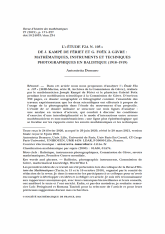L' "étude F2a n. 105" de J. Kampé de Fériet et G. Foëx à Gâvre : mathématiques, instruments et techniques photographiques en balistique (1918-1919)
The "Étude F2a n. 105" of J. Kampé de Fériet et G. Foëx in Gâvre: Mathematics, instruments and photographic techniques in ballistics (1918-1919))

- Consulter un extrait
- Année : 2021
- Fascicule : 2
- Tome : 27
- Format : Électronique
- Langue de l'ouvrage :
Français - Class. Math. : 01A60, 01A74
- Pages : 171-227
- DOI : 10.24033/rhm.227
Dans cet article nous nous proposons d'analyser l'« Étude F2a n. 105 » [SHD-Marine, série H, Archives de la Commission de Gâvre], réalisée par le mathématicien Joseph Kampé de Fériet et le physicien Gabriel Foëx pendant leur mobilisation scientifique à la Commission de Gâvre. D'environ 330 pages, ce dossier autographié et lithographié contient l'ensemble des travaux expérimentaux que les deux scientifiques ont effectués à propos de l'usage de la photographie dans l'étude du mouvement d'un projectile. L'étude de ce dossier militaire se structure sur trois lignes d'analyse : une analyse en termes d'acteurs, qui conduit à discuter les conditions d'exercice d'une interdisciplinarité et le mode d'interactions entre acteurs mathématiciens et non-mathématiciens ; une ligne plus épistémologique qui se focalise sur les rapports entre les savoirs mathématiques et les techniques expérimentales mises en oeuvre dans le cadre de la balistique ; enfin une analyse qui considère les modes de circulation des savoirs et les transferts technologiques opérés suite aux expériences détaillées dans le dossier. Ces aspects déboucheront sur quelques éléments de réflexion concernant la spécificité de la trajectoire de Kampé de Fériet dans la reconfiguration du paysage mathématique moderne, caractérisé par un intérêt renouvelé pour les mathématiques appliquées, les travaux expérimentaux en équipe et par un renforcement des liens entre les universités, l'industrie et les institutions militaires.

